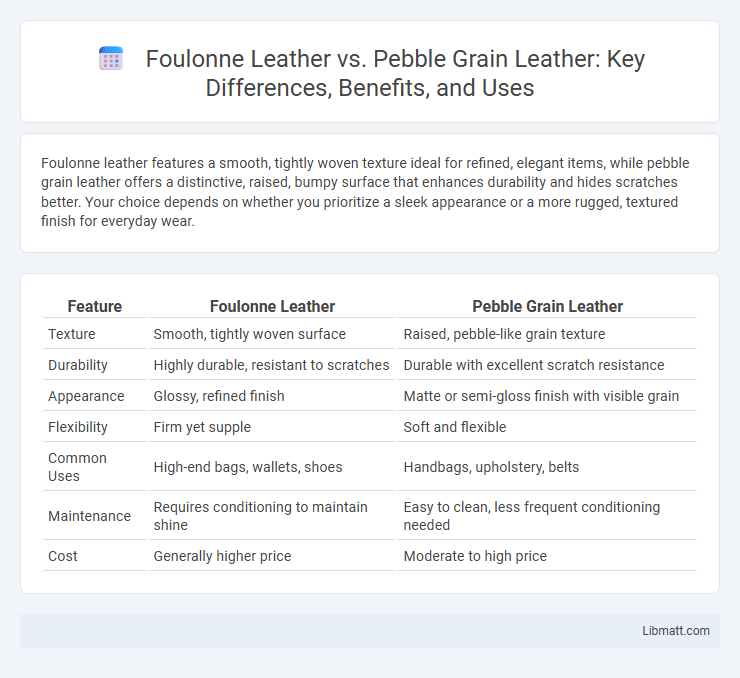Foulonne leather features a smooth, tightly woven texture ideal for refined, elegant items, while pebble grain leather offers a distinctive, raised, bumpy surface that enhances durability and hides scratches better. Your choice depends on whether you prioritize a sleek appearance or a more rugged, textured finish for everyday wear.
Table of Comparison
| Feature | Foulonne Leather | Pebble Grain Leather |
|---|---|---|
| Texture | Smooth, tightly woven surface | Raised, pebble-like grain texture |
| Durability | Highly durable, resistant to scratches | Durable with excellent scratch resistance |
| Appearance | Glossy, refined finish | Matte or semi-gloss finish with visible grain |
| Flexibility | Firm yet supple | Soft and flexible |
| Common Uses | High-end bags, wallets, shoes | Handbags, upholstery, belts |
| Maintenance | Requires conditioning to maintain shine | Easy to clean, less frequent conditioning needed |
| Cost | Generally higher price | Moderate to high price |
Understanding Foulonne Leather: Definition and Features
Foulonne leather is a high-quality, smooth-textured leather characterized by its tight, fine grain and durability, often produced through a unique tanning process that enhances softness and water resistance. Unlike pebble grain leather, which displays a raised, textured surface with visible grain patterns for added grip and a rugged look, foulonne leather offers a sleek, polished finish ideal for refined leather goods. Your choice between these leathers depends on whether you prefer the elegant smoothness of foulonne or the tactile, durable texture of pebble grain.
What is Pebble Grain Leather? Key Characteristics
Pebble grain leather is a type of full-grain leather distinguished by its raised, textured surface featuring small, round pebble-like patterns that provide enhanced durability and resistance to scratches. This leather is prized for its natural look and ability to hide wear and scuffs better than smooth leathers like foulonne. Your choice of pebble grain leather offers a sturdy, stylish option ideal for handbags, shoes, and upholstery where both aesthetics and longevity matter.
Manufacturing Process: Foulonne vs. Pebble Grain Leather
Foulonne leather is crafted through a traditional French tanning method involving vegetable tanning and hot rolling, which produces a smooth, glossy finish rich in character and durability. Pebble grain leather undergoes an embossing process where the surface is stamped with a textured pattern during or after tanning, enhancing resistance to scratches and providing a distinctive pebbled appearance. Your choice depends on whether you prefer the natural, refined elegance of Foulonne or the rugged, textured durability of pebble grain leather.
Texture and Appearance Comparison
Foulonne leather features a smooth, tightly woven texture with a subtle sheen that highlights its fine craftsmanship, making it ideal for elegant, polished accessories. Pebble grain leather offers a distinctive, raised pattern with a textured surface that provides a rugged, casual look while enhancing durability and resistance to scratches. Choosing between these leathers depends on Your preference for either refined sophistication or a more textured, resilient appearance.
Durability and Longevity: Which Leather Is Stronger?
Foulonne leather features a tight, smooth weave that enhances resistance to scratches and scuffs, making it highly durable for long-term use. Pebble grain leather's textured surface offers excellent flexibility and hides wear and tear better, but may be less resistant to deep cuts compared to Foulonne. Your choice depends on whether you prioritize the sleek toughness of Foulonne or the resilient, textured durability of pebble grain for longevity.
Maintenance and Care Tips for Both Leathers
Foulonne leather requires regular conditioning to maintain its smooth, supple texture and prevent drying or cracking, while pebble grain leather benefits from gentle cleaning with a damp cloth to preserve its distinctive textured surface and resist dirt. Both types should be kept away from direct sunlight and excessive moisture to avoid fading and damage, with a leather protector applied periodically to enhance durability. Your maintenance routine will ensure the longevity and appearance of either foulonne or pebble grain leather, keeping your items looking pristine.
Price Differences: Foulonne vs. Pebble Grain Leather
Foulonne leather typically commands a higher price than pebble grain leather due to its intricate weaving process and luxurious texture, making it a premium choice for upscale leather goods. Pebble grain leather offers durability and a distinctive raised texture at a more affordable cost, appealing to those seeking quality without a steep investment. Understanding these price differences helps you make an informed decision based on budget and desired leather characteristics.
Common Uses and Product Applications
Foulonne leather is widely used in luxury handbags, upholstery, and high-end footwear due to its smooth, refined surface and durability. Pebble grain leather is popular for wallets, phone cases, and casual shoes because of its textured, pebbled finish that offers improved grip and resistance to scratches. Both types are favored in fashion and accessory industries but cater to different style preferences and functional needs.
Style and Aesthetic Preferences
Foulonne leather features a smooth, tightly woven grain that exudes a refined, polished look ideal for formal and classic styles. Pebble grain leather, with its textured, raised surface, offers a casual yet sophisticated aesthetic that enhances durability and hides imperfections. Choosing between the two depends largely on desired visual appeal and how the leather complements specific fashion or design preferences.
Choosing the Right Leather: Foulonne or Pebble Grain?
Foulonne leather features a smooth, tightly woven grain that offers a refined, polished appearance ideal for formal accessories and garments, while pebble grain leather is characterized by its distinct textured surface, providing enhanced durability and resistance to scratches, perfect for everyday use. Your decision should consider the intended use, balancing the sleek elegance of Foulonne leather with the rugged practicality of pebble grain leather to match your style and lifestyle needs. Both leathers offer unique strengths in texture and longevity, making them versatile choices depending on whether you prioritize aesthetic or functional qualities.
Foulonne leather vs pebble grain leather Infographic

 libmatt.com
libmatt.com